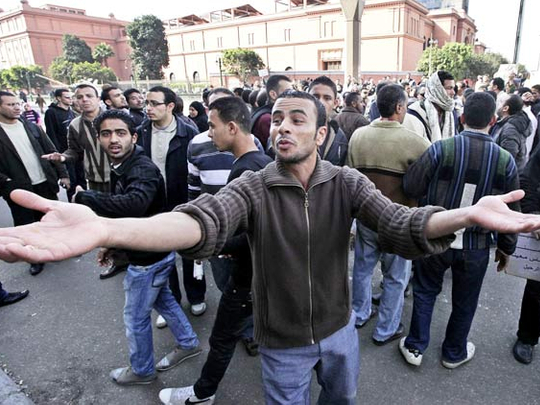
The pictures told a thousand stories of horrors and would-be horrors. Special forces soldiers standing guard, fully armed, in the middle of the Egyptian Museum, amidst some of the most treasured legacies of humankind.
Yes, the scenes were from the day after at Cairo's world-famous home to the treasures of the Pharaohs that was attacked by a mob. The would-be looters broke into the museum while the nation's attention was riveted on the Tahrir Square protests, ripping the heads of two mummies and damaging some 75 rare artefacts before being stopped by soldiers and apprehended.
I couldn't control my anger — nor the tears that welled up in my eyes — as I watched on television this vandalism that targeted antiquities that are the envy of the whole world.
The unquestioned doyen of Egypt's antiquities, Dr Zahi Hawass, Director of the Supreme Council of Antiquities, who was also recently promoted to minister of state, rushed to the scene and reported that despite the damage caused, nothing was missing from the collection and that the prized collection was now safe under military guard.
As an Arab, extremely proud of his heritage, I cried because the incident brought back memories of what had happened in Iraq in 2003 soon after the US-led war to topple Saddam Hussain began, and the more brazen, televised destruction of the Buddhas of Bamiyan by the Taliban in Afghanistan in 2001.
The sight of looters of Iraq's Mesopotamian treasures was amazing for George W. Bush at that time, but that did not stop the relentless pillage that followed under the very noses of the American occupation forces. Priceless artefacts have been smuggled out into the international black market, many never likely to be recovered again.
Cairo proves that history shamelessly repeats itself, but not always in the manner predicted or feared. Senseless acts of vandalism, often driven by baseless denial of humanity's legacy, are not uncommon during social-political turmoils of the kind one has witnessed in Egypt over the past many weeks.
Sometimes lax security and bureaucratic indifference encourage such incidents. Last year, the theft of a Van Gogh painting from a museum in Cairo brought attention to outdated alarm and camera systems and other troubling lapses in security.
Hawass has long campaigned to bring home ancient artefacts spirited out of the country during colonial times. Last month, just before anti-government protests erupted, he formally requested the return of the 3,300-year-old bust of Queen Nefertiti that has been in a Berlin museum for decades.
Seven sites are classified as World Heritage in Egypt, but there are hundreds of archaeological sites. These are most at risk. As foreign researchers fled the country and neighbourhood fires threatened the Cairo Museum this month, Hawass told Irina Bukova, the Unesco Secretary General, that "all necessary measures have been taken to safeguard the treasures of Egypt, especially in Cairo, Luxor and other historical sites …"
In reality, though, there can be no guarantees in such matters. Revolutions have always led to excesses of ignorance, and the losses of each have proved disastrous to humanity as a whole. During the French Revolution, the revolutionaries destroyed 28 statues of the kings of Israel and Judah that adorned the facade of Notre Dame, because they mistakenly believed they were of the kings of France.
Damaged tombs
Archaeologists around the world were horrified at the pillage of the principal Pharaonic museum, which has some 120,000 exhibits. Shockingly, members of the tourism security forces themselves were among the vandals, according to museum director, Wafaa Al Sadiq (quoted by Der Tagesspiegel magazine).
However, French archaeologist Jean-Pierre Corteggiani was encouraged to see that dozens of Cairenes volunteered to form a security chain around Cairo Museum to prevent further depredations. Hawass has declared on Al Jazeera TV that the army had taken control of the damaged tombs at Saqqara, saying "We cannot be like Afghanistan." But Philippe Collombert, head of the French archaeological mission in Saqqara, is not satisfied, pointing out to gangs of looters digging around the site.
Hawass has recognised only one other incident of pillage in the provinces, at a museum depository in Port Said. "We do not know exactly how many objects were taken, but a total of six boxes have disappeared. They contained inventories from the site of Qantara, in Sinai," said Jacques Kinnaer, a Belgian Egyptologist and founder of Egyptian cultural heritage website that disseminates information on the country's stolen treasures.
"Port Said has recovered 288 objects and I'm sure others will be returned," Hawass has promised. It is reassuring that many of Egypt's museums and ancient monuments, including the Pyramids of Giza, are secure despite upheaval in the streets, and the authorities managed to recovered nearly 300 archaeological items that were plundered by armed Bedouin in the Sinai Peninsula.
Kinnaer has urged officials around the world, art dealers, collectors, and in general anyone who felt affected by this tragedy, to be on the look out for objects that they suspect could have been from Egypt. In the all-consuming turmoil that engulfed Egypt, it had fallen on the rest of the world to take on the challenge of protecting civilisation's most cherished heritage.
Shakir Noori is a senior editor and writer who resides in Dubai and Paris.








